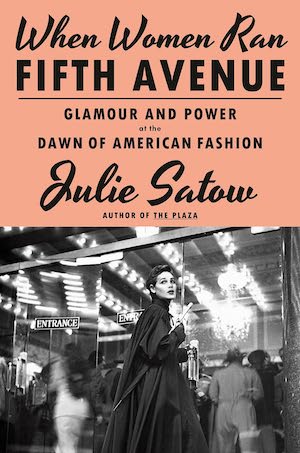When Women Ran Fifth Avenue by Julie Satow
Three women, three stores and a vanished world.
You may be lucky enough to remember Lord & Taylor, Bonwit Teller and Henri Bendel — fabulous emporiums that drew elegant women shoppers from all over the world. Alas, times changed and the stores declined. Malls, catalogues, discount stores and the internet conspired to leave few of them standing.
Indeed, the department stores where women once “reigned as consumers,” in the words of journalist Julie Satow, do not play a big part in the twenty-first century experience. Fortunately, Satow brings them back to life in her new book, When Women Ran Fifth Avenue, Glamour and Power at the Dawn of American Fashion (Doubleday), a history of three iconic Manhattan department stores and the women who transformed them into multi-million-dollar businesses.
New Opportunity Arising
Unsurprisingly, Paris became home to the world’s first department store, Bon Marche, in 1838. A few years later, a Scottish-born retailer, A.T. Stewart, started planning New York City’s first department store, a five-story “marble palace” which opened its doors in 1846. By the early twentieth century, as Manhattan continued to expand northward, merchants were commissioning equally sumptuous stores along upper Fifth Avenue.
And by 1918, when future Lord & Taylor president Dorothy Shaver arrived in New York City from the Midwest, Fifth Avenue was well on its way to becoming more commercial than residential. Like thousands of other ambitious young women, Dorothy stepped off the 20th Century Limited hoping to launch a career, although she hadn’t the faintest idea what it would be. She could not have known that her arrival coincided with a new era in American culture.
In the years following World War I, the population of the United States shifted from rural areas to cities. Urban life, along with the rise of modernism in art, manners, and ideas, spurred the development of a consumer society in which the purchase and conspicuous display of goods signified prestige and sophistication.
And thanks to the proliferation of print media, advertising and marketing reached more Americans than ever before. As the 1920s advanced, middle- and upper-class women came to possess more leisure time and disposable income. No wonder the department store became both a purveyor and a pastime.
Three Trendsetting, Trailblazing Women
When Women Ran Fifth Avenue focuses on the women presidents of three stores: Bonwit Teller’s Hortense Odlum, Lord & Taylor’s Dorothy Shaver, and Henri Bendel’s Geraldine Stutz. Their pathways contrast starkly with each other just as the stores over which they presided contrasted in style and merchandising.
Notably, Stutz, whose tenure at Bendel’s began in 1957, was the only one of the three who attended college and actively pursued a career in fashion. When she innovated the “street of shops” — a gallery of boutiques that opened up the dark, cloistered first floor of the Bendel’s building on 57th Street — Stutz relied on her deep understanding of the industry as well as her own sharp instincts.
Dorothy Shaver and Hortense Odlum, born respectively in Arkansas and Utah, followed less typical routes to success. Dorothy and her sister created and marketed a doll family, “the little Shavers,” that eventually got the attention of Lord & Taylor president Samuel Reyburn. He hired Dorothy to run the store’s “comparison shopping” department in 1921 and she was off and running.
Hortense was literally plucked from domesticity after her husband, a lawyer, purchased the once-glorious department store Bonwit Teller during the Depression. In the blink of an eye, he asked his wife to leave homemaking behind in Brooklyn in order to manage a major turnaround at Bonwit’s — and she succeeded. Her first change, in 1934, was to move the hat department to the first floor.
“The American Look”
Confidence, strategic thinking and imagination characterize the three women profiled in When Women Ran Fifth Avenue. “Who cares about the past?” was Dorothy Shaver’s standard retort to objections to her groundbreaking plans for the store. She introduced personal shopping, “the American Look,” and an interior decorating service.
Yet one returns to the poignancy of “Tenny” Odlum’s life. Evidently her wily husband had a secret motive for planting his wife in the president’s office. He wanted her out of the way so that he could pursue an affair with a younger woman, whom he married in 1935.
While department stores no longer line Fifth Avenue, readers will learn that neither fashion nor the challenges faced by women executives have changed much in the past century. Julie Satow has written an engaging history that feels right at home in the age of influencers.






